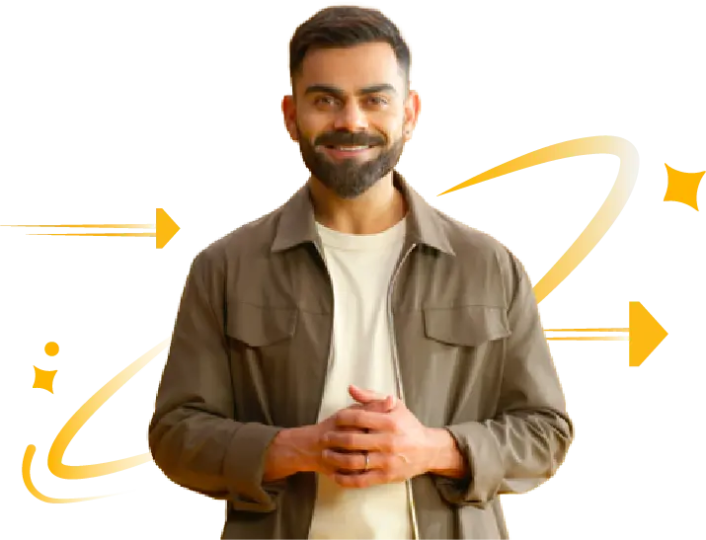7 Crore+ Customers

Affordable Premium

General Insurance
Life Insurance
Claims
Resources

New business prospects for technological advances, applications, and resource utilisation are created by lunar exploration. Because it can inspire people, push the boundaries of human technological capability, and help us learn more about our solar system, countries are interested in sending people to the moon.
This is why India has introduced the Chandrayaan mission, which aims to explore the moon like no other country has before. Continue reading the article to learn about India’s Chandrayaan missions to the moon and the differences between each mission.
Chandrayaan is India's lunar exploration program, consisting of various missions to explore the Moon. Chandrayaan 1, launched in 2008, was India's first mission to the Moon, followed by Chandrayaan 2 in 2019 and Chandrayaan 3 in 2023. These missions are part of India's efforts to study the Moon's surface, mineral composition, and geology, contributing to global lunar exploration efforts.
The Indian Lunar Exploration Programme includes a rover spacecraft, a soft lander, an impactor, and a lunar orbiter. Till now, three missions have been carried out; the first two missions consisted of orbiters, landers, and rovers. However, Chandrayaan 3, the third mission, did not have an orbiter.
Indian Space Research Organisation (ISRO) is currently conducting the Chandrayaan series of lunar exploration missions. The series consists of:
| Mission | Craft | Landing Date |
| Chandrayaan 1 | Moon Impact Probe | 14 November, 2008 |
| Chandrayaan 2 | Vikram | 6 September, 2019 |
| Chandrayaan 3 | Vikram, Pragyan | 23 August, 2023 |
On October 22, 2008, India's first lunar mission, Chandrayaan 1, was successfully launched from SDSC SHAR, Sriharikota. In May 2009, after achieving all primary mission goals, the orbit was boosted to 200 km. After the satellite completed over 3400 moon orbits, communication with the spacecraft was lost on August 29, 2009, marking the end of the mission.
On July 22, 2019, at 14:43, the GSLV MkIII-M1 successfully launched the Chandrayaan 2 mission from the Satish Dhawan Space Centre (SDSC), Sriharikota. On September 7, an attempt was made to land Vikram, which descended according to the prearranged trajectory from its orbit of 35 km to around 2 km above the surface. There was no longer any communication with the lander or ground station.
On 23 August, 2023 LVM3 from SDSC SHAR in Sriharikota launched Chandrayaan 3. The goal of Chandrayaan 3, a follow-up mission to Chandrayaan 2, is to show that it is possible to safely land and roam the lunar surface from start to finish. This mission was a major success for ISRO.
Although the first two Chandrayaan missions failed, Chandrayaan 3's first soft landing and on-site science mission carried out the first experiments in the lunar south pole region. Here are a few important of the Chandrayaan Programmes:
Chandrayaan missions aim to explore the Moon and study its surface, composition, and mineralogy. These missions contribute to our understanding of planetary science and lunar geology.
Each Chandrayaan mission incorporates advanced spacecraft design, navigation, propulsion, and communication technologies. These advancements have practical applications in satellite technology and space exploration.
Successfully conducting lunar missions enhances India's reputation in the global space community. It demonstrates India's capability to undertake complex space missions independently.
Chandrayaan missions often involve international collaboration from space agencies in the US, Europe, and Australia, among others, fostering partnerships with other space agencies and promoting scientific cooperation on a global scale.
Exploring the Moon's resources, such as water, ice and minerals, could have future implications for space exploration and colonisation efforts. Hydrogen may be a renewable energy source if extracted from water (on the moon).
Chandrayaan missions inspire young scientists, engineers, and students in India and worldwide to pursue careers in science and technology. They also raise public awareness and interest in space exploration.
Although Chandrayaan 2 and Chandrayaan 3, both missions are somehow similar to each other, there are a few points of differences among the two. The table given below outlines the difference:
| Basis | Chandrayaan 2 | Chandrayaan 3 |
| Launch Date | Chandrayaan 2 was launched on July 22, 2019. | Chandryaan 3 was launched on July 14, 2023. |
| Approach | Three main parts of Chandrayaan 2 were the orbiter, the Vikram Lander, and the Pragyan Rover. It used a success-based strategy, hoping to land successfully in a 500 m x 500 m rectangle. | A failure-based strategy was the foundation for Chandrayaan 3 to guarantee the project's success. It was missing the orbiter and consisted of a rover named Pragyan and a lander named Vikram. It aimed to safely land in a 4 km × 2.4 km region. |
| Aim | Studying the lunar terrain, mineralogy, elemental abundance, and exosphere was the main goal of Chandrayaan 2, along with looking for water ice in the polar regions. | The objectives of Chandrayaan 3 were to soft land on the lunar surface, send a rover from the lander to explore the south pole, investigate the composition and distribution of water on the surface, examine the surface's mineralogy and geology, and investigate the lunar environment and its role in the evolution of the moon. |
| Design | It comprises the Indian-produced Pragyan rover, the Vikram lunar lander, and the lunar orbiter. The purpose of the lander was to carry out India's first-ever gentle lunar landing. Chandrayaan 2 had five legs and a central push. | The goal of Chandrayaan 3 is to develop and demonstrate new technologies needed for interplanetary missions. It consists of an indigenous Lander module (LM), a Propulsion module (PM), and a Rover. |
| Apparatus | The Chandrayaan 2 orbiter carried apparatus Nine instruments. Chandrayaan 2 had a single computer on board. | The Spectro-Polarimetry of Planet Earth is the only instrument carried by the Chandrayaan 3 satellite. Chandrayaan 3 had two computers on board. |
| Payloads and Scientific Instruments | Science-related packages on Orbiter, Lander, and Rover were part of the Chandrayaan 2 mission. The Lander’s payload consists of LP, RAMBHA, ChaSTE, and ILSA. | The shape payload carried by Chandrayaan 3 is in addition to the NASA-supplied RAMBHA, ChaSTE, LP, and ILSA payloads, while the Rover payloads are unchanging. |
Although both mission’s goals and payloads are different, they have some similarities. Below are a few similarities among the two:
Both missions are undertaken by ISRO, India's premier space agency, showcasing its capability in lunar exploration. The primary objective of both missions is to explore the Moon, particularly to study its surface, terrain, and composition, and search for water ice.
The most potent launch vehicle in India, the GSLV Mk III, is used by both Chandrayaan 2 and Chandrayaan 3. The spacecraft is successfully launched into orbit and placed on the intended lunar trajectory thanks to this cutting-edge rocket technology.
The main goals of both missions are to explore the Moon and learn more about its composition, terrain, and other lunar phenomena. Their goal is to acquire important scientific information that will further our understanding of Earth's nearest planetary neighbours.
Both missions were launched using ISRO's GSLV Mk III launch vehicle, demonstrating India's proficiency in launching heavy payloads to lunar orbit. Chandrayaan 2 had the Vikram lander and Pragyan rover, while Chandrayaan 3 was designed to carry a similar lander and rover.
Both lunar missions seek to increase our understanding of the Moon while supporting India's space exploration programme. The ongoing Indian Space Research Organisation (ISRO) lunar mission, Chandrayaan 3, has the potential to advance space exploration.
Despite difficulties encountered during the landing phase, Chandrayaan 2 accomplished important milestones. We can understand the innovations and distinctive contributions each mission makes to India's lunar exploration efforts by contrasting these two projects.
Chandrayaan 2 and Chandrayaan 3 are Indian lunar missions undertaken by ISRO (Indian Space Research Organisation) to explore the Moon.
Yes, both missions share the objective of exploring the lunar surface, studying its composition, and enhancing our understanding of the Moon's geology.
No, Chandrayaan 3 does not have an orbiter. It will focus solely on achieving a successful soft landing on the Moon's surface and deploying a rover for scientific exploration.
Just before the touchdown, Vikram, the lander on Chandrayaan 2, lost connection due to a software malfunction.
Yes, despite the landing failure, Chandrayaan 2 achieved about 90 to 95 percent of its mission goals.
No, a lunar landing will not be attempted by Chandrayaan 3. It won't have a lander component and will instead concentrate on other goals.
Unlike the previous Chandrayaan 2 mission, which attempted to land on a 500 m by 500 m patch, the current mission is directed to land safely anywhere within a 4 km x 2.4 km area.
Compared to Chandrayaan 2, Chandrayaan 3 will be a more autonomous mission. Since human intervention will not be possible until the lander and rover arrive on Chandrayaan 3, they can function with more autonomy.
No, one lunar day or fourteen earth days was the lifespan intended for the Chandrayaan 3. The first mission of its kind, India's Chandrayaan 3, to the moon's south pole, never woke up.
One lunar day was intended to be its duration. However, when the sun set on September 30, there was hope that a fresh dawn would bring the lander and rover out of hibernation so they could resume their investigations. They did not, however, make it through the icy lunar night cycle.
No, the trajectory deviated at a height of 2.1 kilometres, and telemetry was lost just before touchdown. The rover was not launched after the Lander malfunctioned.
The Chandrayaan 3 lander and rover were designed, according to ISRO, to last for one lunar daylight cycle, or around fourteen Earth days. A similar mission period elapsed for Chandrayaan 2 before an incident on the Moon's far side.
Yes, there are three primary parts to Chandrayaan 3: a lander module, a rover, and a propulsion module.